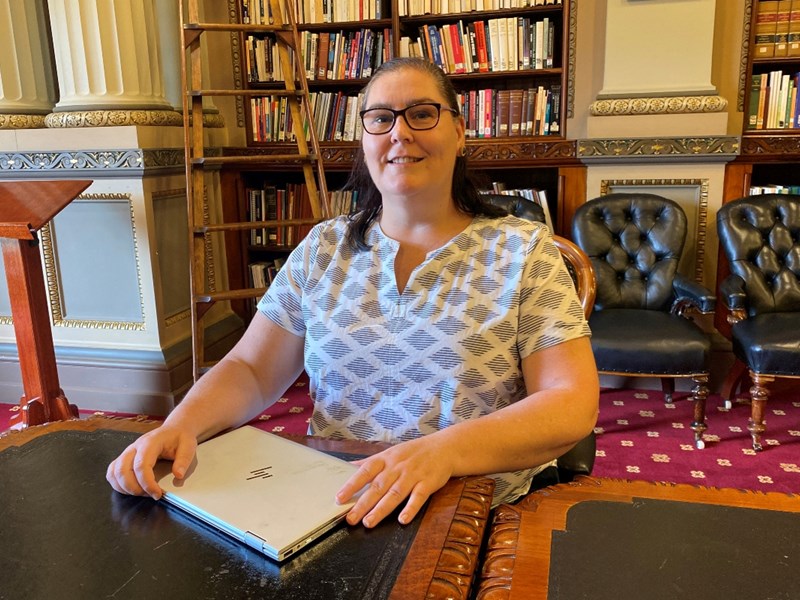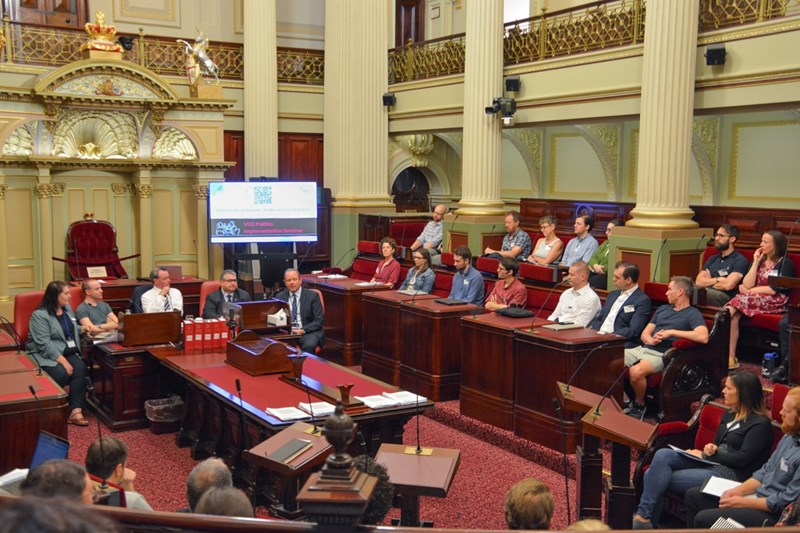- Home /
- News /
- General news
Connecting students to parliament through the power of storytelling
24 January 2024

‘I love stories, and I use stories a lot in my teaching,’ says Parliament of Victoria education specialist Narelle Wood.
This simple proposition is a key component of her long-term strategy for developing parliamentary education material.
Narelle joined the community engagement team in mid-2020. Since then, she has delivered online and in-person teacher professional development, redeveloped education resources (tailored to students of varying ages to improve student engagement) and collaborated with external organisations to create educational material and events.
Narelle was drawn to parliament to combine her experience in community engagement work at Deakin University with state-wide education across all age groups.
She has loved the collaborative aspect of her role and says working with Worawa Aboriginal College on the recently completed Aboriginal Change Maker’s project ‘was and always will be a career highlight’.
This freedom to work with other professionals, such as experts in parliamentary procedure and graphic designers, has enabled her to develop resources that are not only comprehensive but look great as well.

She says development of these sorts of resources is an opportunity ‘you rarely get in the classroom’.
With experience ranging from primary to tertiary education, and having completed a PhD in education, her passion and knowledge in the space are self-evident.
Drawing on this experience, Narelle is taking a new approach to increase connections with teachers and students.
‘The empathy that comes through stories is nuanced and complex and you may not really be able to demonstrate that in other ways,’ she says.
‘People often see the learning process as simply providing students with an explanation.’
Diversifying how students engage with parliament and civic concepts, including providing a range of language to describe parliamentary processes, is a key step to improving accessibility within education material.
Looking at ways to provide more multi-modal resources is high on the agenda of future plans. By providing text as well as images, diagrams, and video material (as was done in the Aboriginal Change Makers resource) Narelle believes parliament education material will have a broader reach.
However, accessibility isn’t the only factor that contributes to strong engagement.
‘One of the things we know, that makes a difference in education, is students being able to connect learning with their everyday lives.’
This has led to the development of the ‘Engaging Perspective’ flashcards and the ‘Challenging Conversations’ teacher guides. Both these resources provide classroom strategies to help teachers and students talk about issues, with the added bonus of providing connections back to the work of parliament.
This, she says, is where stories come in.
‘Parliament makes laws for all of Victoria. These can be really big concepts that you’re asking people to care about, so how do we find those personal stories that people can identify with?'
Narelle believes that the Victorian Parliament is a great area of focus to connect students’ personal experience to broader legislative change, because so many of the decisions made relate to young people’s lived experience.
Future learning tools and programs will include tangible examples of the role parliament plays in the everyday lives of students. Due for release in February 2024 is a series of videos on Leadership and Advocacy in which MPs and young advocates talk about how they represent their respective communities.
This series was developed out of a co-design in the civics classroom program, where student leaders were curious to find out how to engage with students they don’t really hear from and how to make good decisions based on their peers’ perspectives. The videos promote the relevance of Victoria’s governing system to young people, improving engagement and the quality of learning that takes place.

Simultaneously teaching about both the state and federal systems provides further context and understanding for students, Narelle says.
‘The Parliamentary Education Office in Canberra does an amazing job of connecting students with the federal system, and we don’t repeat that. Instead, we compare and contrast the systems of government to make connections to here in Victoria.’
By exploring both systems together, for instance with the ‘Three Levels of Government’ flashcards resouce, Narelle believes that a more in-depth understanding of our parliamentary system can be established, helping to provide young people with agency; a major goal of her approach to learning.
She believes that a significant step to achieving this is connecting students to parliament through sharing meaningful stories and encouraging students to develop their own.

For more information on parliament's education resources and programs, visit the Teach and Learn webpage or email education@parliament.vic.gov.au. Teachers can also subscribe to the regular Springboard e-bulletin, connecting educators to parliamentary education in Victoria.
About the Author

Xavier O'Brien
This article was written by Xavier O’Brien during a graduate placement he undertook at the Parliament of Victoria.